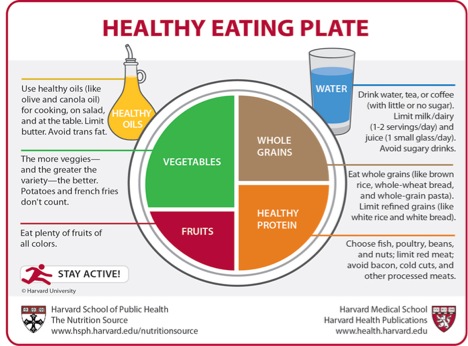Do you feel bombarded with nutrition information and confused on what to eat? You’re not alone. The USDA conducted some consumer research and discovered that people want a more simplified message but more information.
Although the USDA came up with MyPlate earlier this year, nutrition experts at Harvard developed their own Healthy Eating Plate, to help guide you on what to eat. Although their tool builds upon USDA’s MyPlate strategy, Harvard’s experts argue that the USDA’s food guidelines are more influenced by the food industry than science. To remedy this shortcoming, Harvard’s nutrition expert created their own plate which is more specific and science-based.
And this is what they say:
2. A quarter of your plate should be whole grains. Whole grains help lower cholesterol and insulin levels, decrease your risk of diabetes and prevent constipation. Whole grains include brown rice, whole wheat bread, whole wheat and corn tortillas and oats.
3. A quarter of your plate should be a healthy lean protein, less red meat. Choose beans, tofu, nuts, fish and skinless poultry. Red and processed meats have been found to increase your risk of diabetes, heart disease and colon cancer.
4. The “Healthy Eating Plate” also recommends you use healthy oils such as olive, canola, sunflower or flaxseed oil and avoid butter and trans fats.
5. Drink mostly water and non-sugary beverages such as coffee and tea with little or no sugar. Limit 100% juice to one six ounce glass a day, whole fresh fruit is a better choice since it also adds fiber and phytochemicals (plant nutrients). It also recommends a limit of milk/dairy to 1-2 servings a day since some studies have shown no benefit to getting an excess amount of calcium.
6. Stay active. Exercise is just as important as a healthy diet for weight control and better health. Try to get at least the minimum recommendations of 30 minutes a day for five days a week, moderate intensity aerobic activity. And two or more days of strength training activity using all major muscle groups.

